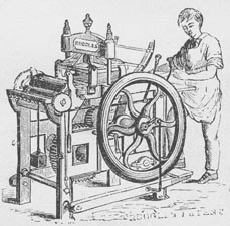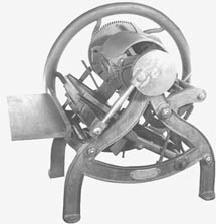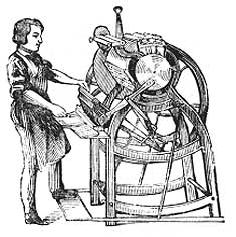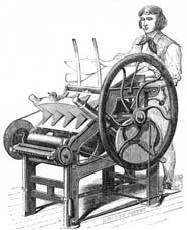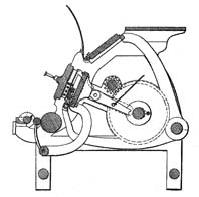|
STEPHEN RUGGLES (1808-1880)
Treadwell was followed by Stephen Ruggles, originally from Windsor, Vermont. He was apprenticed to a printer there and his mech-anical bent appeared early. While still an apprentice he made an attempt to ink the formes of a hand-press by means of an automated self-inking roller. Later, in 1826 he moved to Boston, worked as a pressman and in his spare time devised and built a powered cylinder press, on which the Ladies Magazine was printed. He later designed a platen press, but like Treadwell, could not find adequate tool machinery in Boston to actually make one. (One has to wonder how he constructed his earlier cylinder machine!) It was a compound toggle-jointed platen whose double-frisket carriage put one sheet on the bed as another was being fed.
In his autobiography Ruggles wrote: "In 1830 or 1831, I invented and built, in New York, in Minor's machine shop, the first card or job press, I believe, ever constructed in any part of the world. This press worked with a vibrating platen and was the first press ever contrived to receive, on its platen, the paper or card to be printed." The press was operated by Ruggles in the office of Daniel Fanshaw in the American Tract Society building in New York - and incredibly, it was made from wood! In 1833 he returned to Boston and there continued the manufacture of the press, but with iron instead. Shortly after he was commissioned to develop equipment for the education of the blind. Within 12 months he had designed and manufactured a much needed machine for braille printing the Bible. This 'embosser' mechanism soon developed (1839) into his Engine Press, more a 'bed & platen' type actually. It had a chase size 10 x 14 inches (254 x 356mm). The machine had a stationary type forme above the reciprocating platen below it, i.e the forme was upside down - which no doubt could lead to type falling out and being crushed. The conventional frisket was dis-carded as the sheet was placed directly on the platen into guides -- an advancement which enabled the sheet to be delivered printed side up. Composition rollers automatically inked the forme. 1,200 impressions per hour were claimed for this press, certainly a great improvement on the old hand press.
For several years, Ruggles invented machinery for printers, including stereotype plate shaving machinery, precision lathes and gear designing apparatus. However, Ruggles, still uncon-vinced, decided on a less complicated mech-anism, which he built and patented in 1851. This was known as the Card & Billhead Press, from which the modern jobber is descended. It was designed with a semi-inverted bed (about 60°). Sheet size was 4½ x 7½ inches (114 x 190 mm). The bed consisted of a flattened side of a fixed cast-iron cylinder, the balance of the cylinder acted as an ink distributing surface around which the rollers circulated. The platen oscillated to and fro by means of draw bars attached to crank wheels mounted at both ends of a shaft running through the centre of the stationary bed cylinder, the platen hinged below its lower edge and attached at the rear of the side frames. Two adjustable frisket bars were hinged to the bottom of the tympan to assist sheet separation after impression. A large fountain roller at the back end of the press provided the ink supply.
Actual production of the machine began in 1854 and it became quite popular. This was the first real treadle jobber to be regularly manufactured that looked like any of its successors of later years. It was comparatively simple and reasonably priced. Within a short time, Ruggles brought out two other similar presses. The Diamond Card Press, size 3 x 4½ inches (76 x 114mm) a table-top model and the other was the curiously named Job Rotary Press, (certainly not a rotary) a larger version of his Card & Billhead, which had a 7 x 10 inch (178 x 254mm) chase.
Success with these small card presses encouraged Ruggles to make a larger one; in 1855 he introduced his Combination Job Press, [Patent No. 10588; 1854] which had a sheet size about 15 x 20 inches (380 x 510mm). This was a rather curious looking press with a semi-inverted, (downward-sloping) rigid bed with a hinged platen, driven from a camshaft behind it, but basic mechanicals were not really that much different to his first model, the Engine Press, according to Moran. Not long after he made a still larger machine, called the Book & Magazine Press, but this was not an overly successful venture due to competition from the larger, established press builders.
|
|
